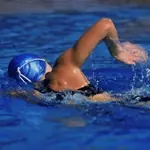
More: Perfect Your Swim Form
There are in-the-water principles that haven't changed?for nearly 20 years. Today, these very same elements remain firmly grounded in teaching and learning how to swim more efficiently.
More: Tri Book Club
Instruction for?beginners to professionals—and assess out-of-water movements—has evolved considerably, but the foundations and principles of the following areas of the freestyle swimming stroke are very much the same.?Purposeful practice is necessary however, and the deliberate training of swimming technique rules over strength and power.
More: Elements of Freestyle Technique
The more you make each stroke unhurried, accurate and controlled, the sooner you'll make positive adaptations that will transfer to greater speed and efficiency as you swim. Make these your "foundations" to build upon and you will, for all intents and purposes, be guaranteed to become a much improved swimmer.
Carry out each of the following and perform them with as precise of movements as possible—with very low intensity and 6 to 10 x 25 yards/meters plus 10 to 15 seconds rest. For example: 6 x 25 leaving each 30, 40 or 50 seconds working the Entry only. If you cannot make each movement accurately, slow down until you can control every motion smoothly and comfortably.
More: A New Approach to Technique
One: The Entry
The hand enters the water, stretching forward, downward and slightly outward while reaching (arcing) for the greatest length possible. The hips and shoulders should be allowed to move and be freely rotating on an axis from side to side. Some athletes have tight hips and performing the entry and stretch may prove difficult, and the legs may split apart as a result. Therefore, making your body can move functionally out of the water improve how you swim.
The initial placement of the hand and forearm into the water at the entry is important for efficient swimming. With proper technique, the swimmer can potentially generate more lift, reduce turbulent drag, and make a more efficient and smooth entry. The entering hands are used to move water away from the front of the body to lessen the resistance of the oncoming flow.
More: Swim Form Checklist
- 1
- of
- 3
About the Author

www.evanscoaching.com | marc@evansoaching.com | YouTube | Facebook








Discuss This Article